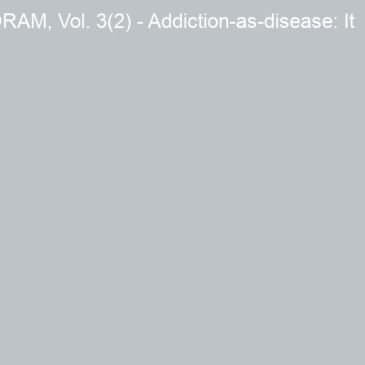Social scientists who study addiction generally agree that the disease concept is historically and culturally constructed (e.g., Gusfield, 1996; Levine, 1978; MacAndrew & Edgerton, 1969; Room, 2003; Seeley, 1962). Reinarman (2005) makes the latest case, arguing that clinical research has yet to pinpoint the source or site of addiction. This is because addiction-as-disease “is a different species of social accomplishment” (Reinarman, 2005, p. 308) whose origins lay in historical, political-institutional, and interactional achievements.
In the early nineteenth century, temperance advocates insisted that beverage alcohol was inherently addicting. Social problems in industrialized America were erroneously attributed to a drinker’s powerlessness to abstain. After the repeal of Prohibition in 1933, however, addiction-as-disease had to be reworked; most drinkers did not become habitual drunkards. Alcoholics Anonymous, the Yale Center of Alcohol Studies, and the National Council on Alcoholism “modernized” addiction-as-disease, convincing medical professionals and the public that only certain individuals were biologically susceptible to alcohol addiction. In the early 1970s, the National Institute on Alcohol Abuse and Alcoholism legitimized this model, providing “crucial institutional support, political legitimacy, and cultural momentum to the more general concept of addiction-as-disease” (Reinarman, 2005, p. 313). Today, addiction-as-disease is accepted as a scientific fact. “This completes the loop and conceals, like a good magic trick, the actual procedures by which it was accomplished” (Reinarman, 2005, p. 315).
Reinarman’s (2005) work is important because it sees past the “conceptual elasticity” of addiction-as-disease to consider how this construct affects those to whom it is applied (p. 307). People with addiction learn what addiction-asdisease looks like and “act” accordingly (Reinarman, 2005). This observation should not be misconstrued, argues Reinarman. Addiction is “real” to those who experience it (p. 316). Yet these interactional processes imply that addiction-as-disease is therapeutically hollow: “the diagnostic inference of a latent state (i.e., addiction) rests upon the consequences of that very same latent state” (Shaffer et al., 2004, p. 371).
What are the alternative paradigms to addiction-as-disease? Two come to mind. The first examines how drug users lose control by studying those who sustain it. Zinberg (1984) popularized this approach, and in his footsteps other researchers suggest that “to rail against the risks of this or that demon drug without understanding the ways in which our own culture makes drug use a thinkable and ‘do-able’ thing is an abdication of analysis” (Waldorf, Reinarman, & Murphy, 1991, p. 282). A syndrome model of addiction is also gaining scientific momentum. Shaffer, LaPlante, LaBrie, Kidman, Donato, and Stanton (2004) posit that addictive disorders follow a similar developmental pattern based on biological and psychological susceptibilities, drug or activity (e.g., alcohol or gambling) exposure, and personal experiences with an addictive object (Odegaard & Shaffer, 2005). “This [syndrome] model requires clinicians to develop multidimensional treatment plans that account for the many relationships among the multiple influences and consequences of addiction” (Shaffer et al., 2004, p. 372).
Zinberg and Shaffer et al. refute pharmacological and object determinism (Reinarman & Levine, 1997), therefore achieving what Reinarman says the concept of addiction-as-disease cannot. Their paradigms, and ones alike in aim and function, “trigger a shift of gaze” (Reinarman, 2005, p. 317) from a discourse about sickness and addicts to a dialogue about health and people.
—Christopher R. Freed
What do you think? Please use the comment link below to provide feedback on this article.
References
Gusfield, J. R. (1996). Contested meanings: The construction of alcohol problems. Madison, WI: The University of Wisconsin Press.
Levine, H. G. (1978). The discovery of addiction: Changing conceptions of habitual drunkenness in America. Journal of Studies on Alcohol, 39(1), 143-174.
MacAndrew, C., & Edgerton, R. (1969). Drunken comportment: A social explanation. Chicago: Aldine Publishing Company.
Odegaard, S., & Shaffer, H. J. (2005). Addiction as syndrome. Paradigm, 9(3), 12-13, 22.
Reinarman, C. (2005). Addiction as accomplishment: The discursive construction of disease. Addiction Research and Theory, 13(4), 307-320.
Reinarman, C., & Levine, H. G. (1997). Crack in context: America’s latest demon drug. In C. Reinarman & H. G. Levine (Eds.), Crack in America: Demon drugs and social justice (pp. 1-17). Berkeley: University of California Press.
Room, R. (2003). The cultural framing of addiction. Janus Head, 6(2), 221-234.
Seeley, J. R. (1962). Alcoholism is a disease: Implications for social policy. In D. J. Pittman & C. R. Snyder (Eds.), Society, culture, and drinking patterns (pp. 586-593). New York: John Wiley & Sons, Inc.
Shaffer, H. J., LaPlante, D. A., LaBrie, R. A., Kidman, R. C., Donato, A. N., & Stanton, M. V. (2004). Toward a syndrome model of addiction: Multiple expressions, common etiology. Harvard Review of Psychiatry, 12, 367-374.
Waldorf, D., Reinarman, C., & Murphy, S. (1991). Cocaine changes: The experience of using and quitting. Philadelphia: Temple University Press.
Zinberg, N. E. (1984). Drug, set, and setting: The basis for controlled intoxicant use. New Haven, CT: Yale University Press.




